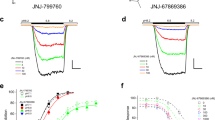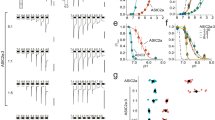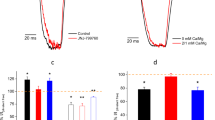Abstract
Acid-sensing ion channels (ASICs) are trimeric1, proton-gated2,3 and sodium-selective4,5 members of the epithelial sodium channel/degenerin (ENaC/DEG) superfamily of ion channels6,7 and are expressed throughout vertebrate central and peripheral nervous systems. Gating of ASICs occurs on a millisecond time scale8 and the mechanism involves three conformational states: high pH resting, low pH open and low pH desensitized9. Existing X-ray structures of ASIC1a describe the conformations of the open10 and desensitized1,11 states, but the structure of the high pH resting state and detailed mechanisms of the activation and desensitization of the channel have remained elusive. Here we present structures of the high pH resting state of homotrimeric chicken (Gallus gallus) ASIC1a, determined by X-ray crystallography and single particle cryo-electron microscopy, and present a comprehensive molecular mechanism for proton-dependent gating in ASICs. In the resting state, the position of the thumb domain is further from the three-fold molecular axis, thereby expanding the ‘acidic pocket’ in comparison to the open and desensitized states. Activation therefore involves ‘closure’ of the thumb into the acidic pocket, expansion of the lower palm domain and an iris-like opening of the channel gate. Furthermore, we demonstrate how the β11–β12 linkers that demarcate the upper and lower palm domains serve as a molecular ‘clutch’, and undergo a simple rearrangement to permit rapid desensitization.
This is a preview of subscription content, access via your institution
Access options
Access Nature and 54 other Nature Portfolio journals
Get Nature+, our best-value online-access subscription
$29.99 / 30 days
cancel any time
Subscribe to this journal
Receive 51 print issues and online access
$199.00 per year
only $3.90 per issue
Buy this article
- Purchase on Springer Link
- Instant access to full article PDF
Prices may be subject to local taxes which are calculated during checkout





Similar content being viewed by others
References
Jasti, J ., Furukawa, H ., Gonzales, E. B. & Gouaux, E. Structure of acid-sensing ion channel 1 at 1.9 Å resolution and low pH. Nature 449, 316–323 (2007)
Krishtal, O. A. & Pidoplichko, V. I. A receptor for protons in the nerve cell membrane. Neuroscience 5, 2325–2327 (1980)
Waldmann, R ., Champigny, G ., Bassilana, F ., Heurteaux, C. & Lazdunski, M. A proton-gated cation channel involved in acid-sensing. Nature 386, 173–177 (1997)
Bässler, E. L ., Ngo-Anh, T. J ., Geisler, H. S ., Ruppersberg, J. P. & Gründer, S. Molecular and functional characterization of acid-sensing ion channel (ASIC) 1b. J. Biol. Chem. 276, 33782–33787 (2001)
Yermolaieva, O ., Leonard, A. S ., Schnizler, M. K ., Abboud, F. M . & Welsh, M. J. Extracellular acidosis increases neuronal cell calcium by activating acid-sensing ion channel 1a. Proc. Natl Acad. Sci. USA 101, 6752–6757 (2004)
Kellenberger, S. & Schild, L. Epithelial sodium channel/degenerin family of ion channels: a variety of functions for a shared structure. Physiol. Rev. 82, 735–767 (2002)
Waldmann, R. & Lazdunski, M. H+-gated cation channels: neuronal acid sensors in the NaC/DEG family of ion channels. Curr. Opin. Neurobiol. 8, 418–424 (1998)
Hesselager, M ., Timmermann, D. B. & Ahring, P. K. pH dependency and desensitization kinetics of heterologously expressed combinations of acid-sensing ion channel subunits. J. Biol. Chem. 279, 11006–11015 (2004)
Zhang, P ., Sigworth, F. J. & Canessa, C. M. Gating of acid-sensitive ion channel-1: release of Ca2+ block vs. allosteric mechanism. J. Gen. Physiol. 127, 109–117 (2006)
Baconguis, I ., Bohlen, C. J ., Goehring, A ., Julius, D. & Gouaux, E. X-ray structure of acid-sensing ion channel 1–snake toxin complex reveals open state of a Na+-selective channel. Cell 156, 717–729 (2014)
Gonzales, E. B ., Kawate, T. & Gouaux, E. Pore architecture and ion sites in acid-sensing ion channels and P2X receptors. Nature 460, 599–604 (2009)
Babini, E ., Paukert, M ., Geisler, H. S. & Gründer, S. Alternative splicing and interaction with di- and polyvalent cations control the dynamic range of acid-sensing ion channel 1 (ASIC1). J. Biol. Chem. 277, 41597–41603 (2002)
Lynagh, T . et al. A selectivity filter at the intracellular end of the acid-sensing ion channel pore. eLife 6, e24630 (2017)
Kellenberger, S ., Hoffmann-Pochon, N ., Gautschi, I ., Schneeberger, E. & Schild, L. On the molecular basis of ion permeation in the epithelial Na+ channel. J. Gen. Physiol. 114, 13–30 (1999)
Kellenberger, S ., Gautschi, I. & Schild, L. A single point mutation in the pore region of the epithelial Na+ channel changes ion selectivity by modifying molecular sieving. Proc. Natl Acad. Sci. USA 96, 4170–4175 (1999)
Snyder, P. M ., Olson, D. R. & Bucher, D. B. A pore segment in DEG/ENaC Na+ channels. J. Biol. Chem. 274, 28484–28490 (1999)
Zhang, P. & Canessa, C. M. Single channel properties of rat acid-sensitive ion channel-1α, -2a, and -3 expressed in Xenopus oocytes. J. Gen. Physiol. 120, 553–566 (2002)
Sutherland, S. P ., Benson, C. J ., Adelman, J. P. & McCleskey, E. W. Acid-sensing ion channel 3 matches the acid-gated current in cardiac ischemia-sensing neurons. Proc. Natl Acad. Sci. USA 98, 711–716 (2001)
Sherwood, T . et al. Identification of protein domains that control proton and calcium sensitivity of ASIC1a. J. Biol. Chem. 284, 27899–27907 (2009)
Gwiazda, K ., Bonifacio, G ., Vullo, S . & Kellenberger, S. Extracellular subunit interactions control transitions between functional states of acid-sensing ion channel 1a. J. Biol. Chem. 290, 17956–17966 (2015)
Li, T ., Yang, Y. & Canessa, C. M. Leu85 in the β1–β2 linker of ASIC1 slows activation and decreases the apparent proton affinity by stabilizing a closed conformation. J. Biol. Chem. 285, 22706–22712 (2010)
Li, T ., Yang, Y. & Canessa, C. M. Asn415 in the β11–β22 linker decreases proton-dependent desensitization of ASIC1. J. Biol. Chem. 285, 31285–31291 (2010)
Li, T ., Yang, Y. & Canessa, C. M. Two residues in the extracellular domain convert a nonfunctional ASIC1 into a proton-activated channel. Am. J. Physiol. Cell Physiol. 299, C66–C73 (2010)
Coric, T ., Zhang, P ., Todorovic, N . & Canessa, C. M. The extracellular domain determines the kinetics of desensitization in acid-sensitive ion channel 1. J. Biol. Chem. 278, 45240–45247 (2003)
Springauf, A ., Bresenitz, P. & Gründer, S. The interaction between two extracellular linker regions controls sustained opening of acid-sensing ion channel 1. J. Biol. Chem. 286, 24374–24384 (2011)
Baconguis, I . & Gouaux, E. Structural plasticity and dynamic selectivity of acid-sensing ion channel–spider toxin complexes. Nature 489, 400–405 (2012)
Vullo, S . et al. Conformational dynamics and role of the acidic pocket in ASIC pH-dependent gating. Proc. Natl Acad. Sci. USA 114, 3768–3773 (2017)
Bonifacio, G ., Lelli, C. I. & Kellenberger, S. Protonation controls ASIC1a activity via coordinated movements in multiple domains. J. Gen. Physiol. 143, 105–118 (2014)
Ramaswamy, S. S ., MacLean, D. M ., Gorfe, A. A. & Jayaraman, V. Proton-mediated conformational changes in an acid-sensing ion channel. J. Biol. Chem. 288, 35896–35903 (2013)
Yokokawa, M ., Carnally, S. M ., Henderson, R. M ., Takeyasu, K. & Edwardson, J. M. Acid-sensing ion channel (ASIC) 1a undergoes a height transition in response to acidification. FEBS Lett. 584, 3107–3110 (2010)
Gourdon, P . et al. HiLiDe—systematic approach to membrane protein crystallization in lipid and detergent. Cryst. Growth Des. 11, 2098–2106 (2011)
Kabsch, W. XDS. Acta Crystallogr. D 66, 125–132 (2010)
Hanson, M. A . et al. Crystal structure of a lipid G protein-coupled receptor. Science 335, 851–855 (2012)
McCoy, A. J. Solving structures of protein complexes by molecular replacement with Phaser. Acta Crystallogr. D 63, 32–41 (2007)
Emsley, P ., Lohkamp, B ., Scott, W. G . & Cowtan, K. Features and development of Coot. Acta Crystallogr. D 66, 486–501 (2010)
Adams, P. D . et al. PHENIX: building new software for automated crystallographic structure determination. Acta Crystallogr. D 58, 1948–1954 (2002)
Mastronarde, D. N. & Serial, E. M. A program for automated tilt series acquisition on Tecnai microscopes using prediction of specimen position. Microsc. Microanal. 9, 1182–1183 (2003)
Zheng, S. Q . et al. MotionCor2: anisotropic correction of beam-induced motion for improved cryo-electron microscopy. Nat. Methods 14, 331–332 (2017)
Zhang, K. Gctf: Real-time CTF determination and correction. J. Struct. Biol. 193, 1–12 (2016)
Voss, N. R ., Yoshioka, C. K ., Radermacher, M ., Potter, C. S. & Carragher, B. DoG Picker and TiltPicker: software tools to facilitate particle selection in single particle electron microscopy. J. Struct. Biol. 166, 205–213 (2009)
Scheres, S. H. RELION: implementation of a Bayesian approach to cryo-EM structure determination. J. Struct. Biol. 180, 519–530 (2012)
Grigorieff, N. Frealign: An exploratory tool for single-particle cryo-EM. Methods Enzymol. 579, 191–226 (2016)
Heymann, J. B. Bsoft: image and molecular processing in electron microscopy. J. Struct. Biol. 133, 156–169 (2001)
Goddard, T. D., Huang, C. C. & Ferrin, T. E. Visualizing density maps with UCSF Chimera. J. Struct. Biol. 157, 281–287 (2007)
Afonine, P. V., Headd, J. J., Terwilliger, T. C. & Adams, P. D. New tool: phenix.real_space_refine. Comput. Crystallogr. Newsletter 4, 43–44 (2013)
Goehring, A. et al. Screening and large-scale expression of membrane proteins in mammalian cells for structural studies. Nat. Protocols 9, 2574–2585 (2014)
Acknowledgements
We thank A. Goehring, D. Claxton and I. Baconguis for initial construct screening and advice through all aspects of the project, L. Vaskalis for help with figures, H. Owen for manuscript preparation, all members of the Gouaux laboratory for their support and the Berkeley Center for Structural Biology and the Northeastern Collaborative Access Team for help with X-ray data collection. This research was supported by the National Institute of General Medical Sciences (5T32DK007680), and the National Institute of Neurological Disorders and Stroke (5F31NS096782 to N.Y. and 5R01NS038631 to E.G.). Additional support was provided by ARCS Foundation and Tartar Trust fellowships. E.G. is an Investigator with the Howard Hughes Medical Institute.
Author information
Authors and Affiliations
Contributions
N.Y. and E.G. designed the project. N.Y. performed biochemistry, crystallography and electrophysiology experiments. N.Y. and C.Y. performed cryo-EM data collection. C.Y. performed the cryo-EM data analysis. N.Y. wrote the manuscript and all authors edited the manuscript.
Corresponding author
Ethics declarations
Competing interests
The authors declare no competing financial interests.
Additional information
Reviewer Information Nature thanks L. Rash and the other anonymous reviewer(s) for their contribution to the peer review of this work.
Publisher's note: Springer Nature remains neutral with regard to jurisdictional claims in published maps and institutional affiliations.
Extended data figures and tables
Extended Data Figure 1 Function of ASIC1a constructs.
a, I–V relationship for ASIC1a and ∆25 constructs between −40 and 60 mV. Individual data points are displayed and are normalized to current amplitudes at −60 mV. Lines represent mean. ∆25: n = 7 cells; ASIC1a: n = 6 cells. Experiments were performed seven (∆25) and six (ASIC1a) times with similar results. b, Representative whole-cell patch-clamp recordings at stepped potentials from −60 mV to 60 mV for ∆25 and ASIC1a. Experiments were performed seven (∆25) and six (ASIC1a) times with similar results. c, Comparison of Hill slopes of activation for ∆25 and ASIC1a channels by unpaired t-test (two-sided, mean ± s.e.m., **P ≤ 0.01, P = 0.0054; 95% confidence interval = −4.949 to −1.053). ASIC1a: n = 7; ∆25: n = 10. Experiments were performed seven (ASIC1a) and ten (∆25) times with similar results. d, Control experiment demonstrating ASIC1a currents evoked by step to low pH under reducing or ambient conditions. Results are representative of seven independent experiments. Data were collected from Sf9 cells infected with BacMam virus containing ∆25 or ASIC1a DNA.
Extended Data Figure 2 Single particle cryo-EM of chicken ASIC1a.
a, SDS–PAGE of purified chicken ASIC1a. b, Representative micrograph of ASIC1a channels embedded in vitreous ice. c, Angular distribution of particle projections. d, Density map coloured according to local resolution. e, Spherical-masked and solvent-corrected FSC curves for density maps and for the refined model to the final 3D reconstruction. f, Representative density for the ASIC1a reconstruction, identified by residue range or domain above.
Extended Data Figure 3 Cryo-EM data processing workflow.
Representative data processing steps for the ASIC1a reconstruction.
Extended Data Figure 4 GAS-domain swap.
a, Omit map |Fo|–|Fc| density contoured at 2σ for a domain-swapped TM2, top view shown in inset. b, Discontinuous TM2 helix stabilized by hydrogen bonds. c, Superposition of resting and open (PDB code: 4NTW, grey) channels demonstrates relative conformations of the GAS belt.
Extended Data Figure 5 Conformational changes at the acidic pocket.
a, b, Superposition of resting and open (PDB code: 4NTW, grey) channels highlights interactions between Arg191, Glu314 and His328 (a) and between Val353, Glu354 and Asn357 with Met211 on an adjacent subunit (b) that stabilize the expanded, high pH conformation of the acidic pocket. c, Local superposition (α1 and α2) of resting and open channels demonstrates the α5 pivot upon activation.
Extended Data Figure 6 State dependence of extracellular fenestrations.
a–c, Resting (a), open (b; PDB code: 4NTW) and desensitized (c; PDB code: 4NYK) channel pore profiles calculated with HOLE software (pore radius: red < 1.15 Å < green < 2.3 Å < purple). d–f, Approximate fenestration sizes for resting (d), open (e) and desensitized (f) channels; approximate fenestration edge is outlined with a solid black line.
Extended Data Figure 7 State-dependent pore conformation.
a, Resting channel pore profile calculated with HOLE software (pore radius: red < 1.15 Å < green < 2.3 Å < purple). b, Plot of pore radius for resting, open (PDB code: 4NTW) and desensitized (PDB code: 4NYK) channels along the three-fold molecular axis. c, d, Conformation of resting and open TMDs viewed from below (c) and the side (d). e, f, Resting and open gates viewed from the side (e) and above (f).
Supplementary information
Activation of ASIC1a
Morph depicting channel activation via transition between high pH resting and low pH open (pdb 4NTW) states. Single subunit colored by domain. (MOV 16881 kb)
Desensitization of ASIC1a
Morph depicting channel desensitization via transition between low pH open (pdb 4NTW) and low pH desensitized (pdb 4NYK) states. Single subunit colored by domain. (MOV 9120 kb)
Rights and permissions
About this article
Cite this article
Yoder, N., Yoshioka, C. & Gouaux, E. Gating mechanisms of acid-sensing ion channels. Nature 555, 397–401 (2018). https://doi.org/10.1038/nature25782
Received:
Accepted:
Published:
Issue Date:
DOI: https://doi.org/10.1038/nature25782
This article is cited by
-
Structural basis for excitatory neuropeptide signaling
Nature Structural & Molecular Biology (2024)
-
Molecular determinants of ASIC1 modulation by divalent cations
Scientific Reports (2024)
-
Structure and mechanism of a neuropeptide-activated channel in the ENaC/DEG superfamily
Nature Chemical Biology (2023)
-
Function and phylogeny support the independent evolution of an ASIC-like Deg/ENaC channel in the Placozoa
Communications Biology (2023)
-
Optical control of PIEZO1 channels
Nature Communications (2023)
Comments
By submitting a comment you agree to abide by our Terms and Community Guidelines. If you find something abusive or that does not comply with our terms or guidelines please flag it as inappropriate.



